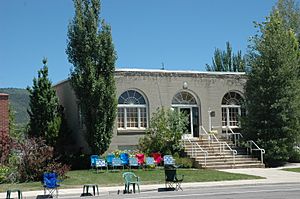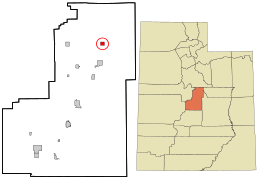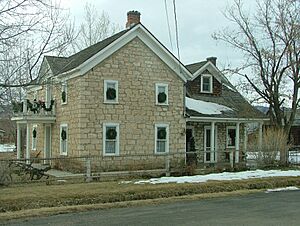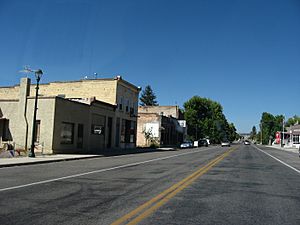Fairview, Utah facts for kids
Quick facts for kids
Fairview, Utah
|
|
|---|---|

Fairview City Hall, July 2011
|
|

Location in Sanpete County and the state of Utah.
|
|
| Country | United States |
| State | Utah |
| County | Sanpete |
| Founded | 1859 |
| Founded by | James N. Jones |
| Area | |
| • Total | 1.26 sq mi (3.26 km2) |
| • Land | 1.26 sq mi (3.26 km2) |
| • Water | 0.00 sq mi (0.00 km2) |
| Elevation | 5,948 ft (1,813 m) |
| Population
(2020)
|
|
| • Total | 1,203 |
| • Density | 954.76/sq mi (369.02/km2) |
| Time zone | UTC-7 (Mountain (MST)) |
| • Summer (DST) | UTC-6 (MDT) |
| ZIP code |
84629
|
| Area code(s) | 435 |
| FIPS code | 49-24630 |
| GNIS feature ID | 1440983 |
Fairview is a city in northern Sanpete County, Utah, United States. In 2020, about 1,203 people lived there.
Contents
History of Fairview
Fairview is located where the San Pitch River and Cottonwood Creek meet. It is the biggest city in the northeast part of the Sanpete Valley.
Founding the City
Fairview was started in 1859. This was soon after the nearby town of Mount Pleasant was settled again. Fairview was one of the first new towns built during the second wave of Mormon settlement in Sanpete County.
In early 1859, James Naylor Jones, Isaac Young Vance, Warren P. Brady, and Jehu Cox were gathering wild hay. They liked the area and asked Brigham Young for permission to start a town. He said yes if there was enough water for thirty families.
On October 1, 1859, a meeting was held in Mount Pleasant. James N. Jones was chosen to lead about twenty families to the new settlement. The town area was measured, and by the end of 1860, a large log meeting house was finished. This building was used for church, school, and social events.
Trees were planted, streets were made, and fences were built. Fairview started to look like a typical Mormon village. In 1864, the town got a post office. It changed its name from North Bend to Fairview. The new name was chosen because the town had a great view of the valley.
Fairview During the Black Hawk War
During the Black Hawk War in the mid-1860s, some people from Fairview moved to Mount Pleasant for safety. This happened after a few men were killed in fights. Those who stayed in Fairview followed Brigham Young's advice to build a fort.
By the end of 1866, a thick rock wall ten feet high surrounded the center of town. After a few years, the fighting lessened. Then, people could start settling and developing the community more. In the next ten years, Fairview's population grew to over 1,000 people. By 1880, it was the fourth largest town in Sanpete County.
In 1900 and again in 1940, the town had more than 1,700 people. However, by 1980, the population was only about 900. This made Fairview the sixth largest town out of nineteen in the county.
Community Life and Economy
Fairview shared its Mormon beginnings and culture with nearby villages. In 1874, the people of Fairview tried to set up a united order. This was a cooperative system where people shared resources. They sold stock certificates to raise money for it. But like most of these orders, Fairview's failed quickly. It faced problems like bad crops and not enough money. The order was stopped in 1876.
From the very beginning, Fairview's economy relied on farming and raising animals. People dug irrigation ditches and found places for reservoirs. They planted food crops, hay, and grains. In 1870, the town's first flour mill was built. Raising animals like beef cattle, sheep, chickens, and turkeys has always been important in Fairview.
Because it was close to canyon forests, sawmills were built early on. These helped the lumber industry. By the early 1900s, there were about six steam sawmills in the mountains east of town.
Growth of Businesses
Starting in the late 1860s, Fairview developed a main street for businesses. This street was along the old road that went through the middle of town. In 1869, a store called Zion's Cooperative Mercantile Institution opened. More stores and businesses followed.
By 1900, Fairview's downtown had a public library, several general stores, a furniture store, a creamery, and other shops. There were also two hotels. In 1881, a Presbyterian mission school was started, and a chapel was built in 1894. A public school system began in the 1890s. In 1898, 497 of Fairview's 1,800 people were students.
When the Rio Grande Western Railroad arrived in the 1890s, it helped the town's economy grow. It became easier to bring in equipment and send out goods. This made Fairview stronger, just like other cities in Sanpete County. The town's economy went up and down with the region's economy after the railroad boom. Its highest population was in 1900.
In the 20th century, new businesses came, like dairies, roller mills, coal mining, and fur farms. The Fairview State Bank was started in 1914. Today, farming and raising animals are still the main ways people make a living. While other parts of the county raise cattle or turkeys, sheep ranching is the most important in Fairview. It makes up 46 percent of the farm and ranch businesses in northeast Sanpete County.
Fairview has many old buildings that show its history. These buildings were made with different materials and styles used by the early settlers. The two LDS meetinghouses from the 1920s-30s show the continuing presence of the Church of Jesus Christ of Latter-day Saints. The two-story rock school (now a museum) and the brick town hall show how important the town used to be. The Fairview Roller Mills reminds us of the town's farming roots.
Geography
Fairview is located at 39°37′44″N 111°26′18″W / 39.628890°N 111.438264°W.
The city covers about 1.2 square miles (3.2 square kilometers) of land. There is no water area within the city limits.
Climate
Fairview has a climate with big differences in temperature between seasons. Summers are warm to hot, and winters are cold, sometimes very cold. This type of weather is called a humid continental climate.
Population Information
| Historical population | |||
|---|---|---|---|
| Census | Pop. | %± | |
| 1860 | 297 | — | |
| 1870 | 531 | 78.8% | |
| 1880 | 863 | 62.5% | |
| 1890 | 844 | −2.2% | |
| 1900 | 1,119 | 32.6% | |
| 1910 | 1,218 | 8.8% | |
| 1920 | 2,287 | 87.8% | |
| 1930 | 2,076 | −9.2% | |
| 1940 | 2,143 | 3.2% | |
| 1950 | 974 | −54.5% | |
| 1960 | 655 | −32.8% | |
| 1970 | 696 | 6.3% | |
| 1980 | 916 | 31.6% | |
| 1990 | 960 | 4.8% | |
| 2000 | 1,160 | 20.8% | |
| 2010 | 1,247 | 7.5% | |
| 2020 | 1,203 | −3.5% | |
| U.S. Decennial Census | |||
In 2000, there were 1,160 people living in Fairview. There were 371 households and 294 families. The population density was about 930 people per square mile. Most of the people (96.03%) were White. About 2.16% of the population was Hispanic or Latino.
Many households (44.7%) had children under 18 living with them. Most households (73.0%) were married couples. The average household had about 3.11 people. The average family had about 3.58 people.
The population was spread out by age. About 35.8% were under 18 years old. About 14.7% were 65 years or older. The average age was 31 years.
Education
Fairview is part of the North Sanpete School District. The city has an elementary school.
Students in Fairview attend North Sanpete High School. This is the main high school for the district.
Notable People and Places
- Spencer Cox, the current Governor of Utah.
- Glade Peterson, a famous opera singer (1928–1990). He founded the Utah Opera Company. He was a main tenor for the Zurich Opera Company for 12 years. He also performed in Milan, Paris, Hamburg, and Vienna. He sang with the Houston Grand Opera, San Francisco Opera, and the New York Metropolitan Opera.
- Fairview Museum of History and Art, a local museum.
See also
 In Spanish: Fairview (Utah) para niños
In Spanish: Fairview (Utah) para niños




